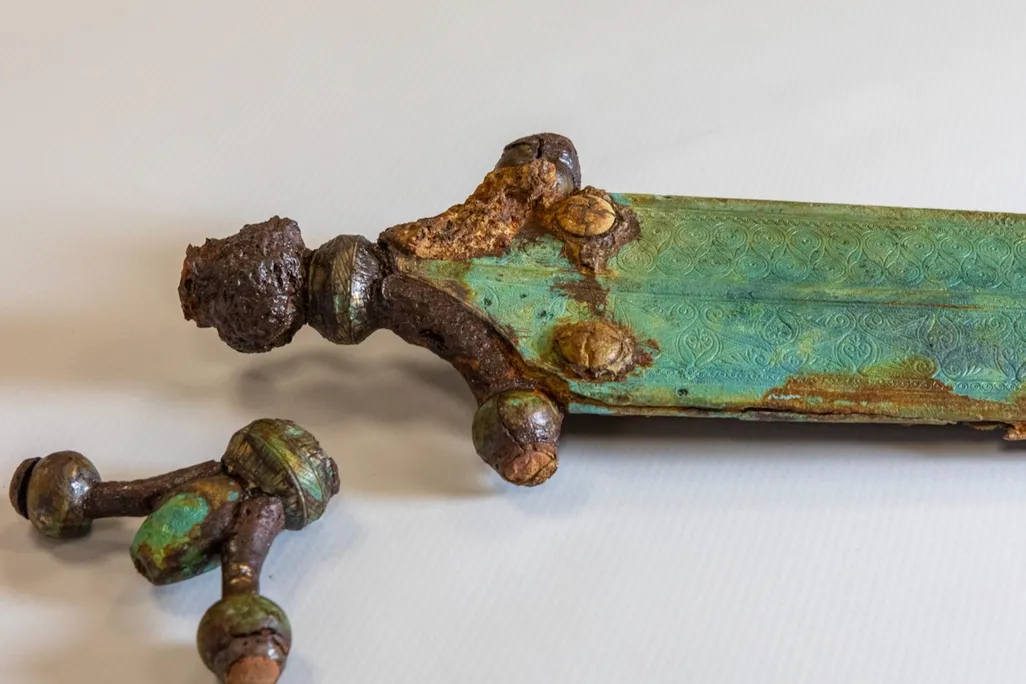WWW.SMITHSONIANMAG.COM
Archaeologists Unearth 2,300-Year-Old Sword Decorated With Two Small Swastikas in a Celtic Necropolis
Cool Finds
Archaeologists Unearth 2,300-Year-Old Sword Decorated With Two Small Swastikas in a Celtic Necropolis
Found in France, the site featured more than 100 graves filled with ancient metal artifacts—including bracelets, brooches and two well-preserved swords
The shorter sword was decorated with polished gems, two of which were carved with swastikas.
Flore Giraud / INRAP
Three years ago, researchers excavated a vast Celtic necropolis in central France. It was filled with ancient metal artifacts, including two expertly crafted 2,300-year-old swords still in their sheaths—one of which was decorated with carved swastikas.
Archaeologists from the National Institute for Preventive Archaeological Research (INRAP) made the discoveries during excavations in the French town of Creuzier-le-Neuf. After extensive analysis, they announced their findings on April 15.
Stretching across 7,000 square feet, the necropolis contained more than 100 graves (including a single cremation burial), according to the announcement. No skeletons remained, as they likely disintegrated in the area’s acidic soil. However, the researchers found metal grave goods in roughly half of the burials.
A map shows the graves inside the necropolis.
INRAP / Sébastien Dohr / Benjamin Oury
Some of the graves held copper-alloy bracelets with clasps, including one that was engraved with circular shapes. The researchers also found 18 brooches made from copper alloy and iron. One such brooch, adorned with a polished gemstone and a silver leaf, dated to the late fourth or early third century B.C.E.
Another brooch was decorated with ocelli, or eye-shaped symbols, which were “fashionable among Celtic craftsmen” in the fifth and fourth centuries B.C.E., Vincent Georges, an archaeologist at INRAP, tells Live Science’s Sahas Mehra. In the cremation burial, researchers also discovered a small vase painted with red bands and spiral patterns.
However, the most significant discoveries were two swords, both protected inside copper-alloy sheaths. One was discovered with rings that would have allowed it to be worn around the waist. Shreds of fabric, likely from the garments of the human it was buried with, still clung to its back, per the announcement. Researchers think it was made during the fourth century B.C.E.
The longer sword featured rings that would have allowed it to be worn around the waist.
Flore Giraud / INRAP
The other sword was shorter, and it had a pointed blade. X-ray scans revealed a circle and crescent moon carved into the top of the blade, suggesting the weapon was also made in the fourth century B.C.E., according to INRAP. Its sheath is adorned with several gems, at least two of which were carved with swastikas.
Long before Adolf Hitler co-opted the swastika as a symbol of the Nazi party in 1920, it was used around the world as an ancient emblem of good fortune. As Smithsonian magazine’s Lorraine Boissoneault wrote in 2017, swastikas have been found on artifacts from India, Europe, Africa, China and the Americas.
Swastikas were common in the ancient Mediterranean. Per Smithsonian, the late-19th century archaeologist Heinrich Schliemann discovered at least 1,800 swastikas on artifacts in present-day Turkey. During the late fifth century B.C.E., the design was adopted by the Celts living in mainland Europe, as Georges tells Live Science. The researcher doesn’t know what meaning the Celts assigned to the symbol.
Researchers think the shorter sword was decorative rather than functional.
Flore Giraud / INRAP
During the Second Iron Age (around 450 to 52 B.C.E.), the recently excavated necropolis was at the crossroads of ancient territories belonging to the Celtic Arverni, Aedui and Bituriges tribes, according to INRAP. Today, the region is occupied by the small town of Creuzier-le-Neuf.
The two swords shed new light on the region’s culture and craftsmanship. As Georges tells Live Science, the longer sword has “all the characteristics of a functional weapon,” and its sheath could have been worn by a horseman. However, the shorter, decorated sword likely wasn’t functional. Instead, it may have been worn as a symbol of power, perhaps by a commanding warrior.
In the fourth century B.C.E., Celtic tribes attacked and defeated Roman forces at the Battle of Allia. While Georges remains cautious about jumping to conclusions, he tells Live Science that the shorter sword is “more or less contemporary with the Celtic incursions in northern Italy and the sacking of Rome in 387 B.C.E.”
Get the latest stories in your inbox every weekday.
